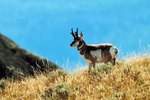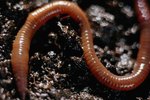
The groundhog (Marmota monax), also known as the woodchuck or whistlepig, are large rodents found across the eastern United States, much of Canada and parts of Alaska. The groundhog is one of 14 species of marmot, but there is only one type of groundhog.
Physical Description
Fairly large for rodents, groundhogs measure between 16 and 26 inches, with tails adding 7 to 9 more inches. They weigh between 4 and 13 pounds, and are at their lightest just after hibernation. They're stocky in appearance, with thick coats ranging in color from gray to dark brown. Their tails are bushy and are usually black or dark brown. Their fur is often tipped with white, giving them a grizzled look.
Habitat
Groundhogs are able to live in a range of habitats. They're most commonly found in fields, pastures, woodland, hedgerows and low elevation forests. Human activity such as agriculture and forest clearing has actually helped rather than hindered these creatures in their natural environments, as it has improved access to food. They like to live in areas with well-drained soil, so they can dig dens. They generally have separate summer dens near food, and winter dens that are well sheltered.
Behavior
Solitary creatures, groundhogs live alone from the time they're weaned at 6 weeks old, coming together only to mate. Two groundhogs will greet one another nose-to-nose when they meet. They also communicate via vocalizations and scent glands. During the summer, theses diurnal creatures can be seen sunbathing during the middle of the day. They generally hibernate during the winter, although those living in the southernmost points of their range will sometimes stay active all year.
Diet
Since groundhogs hibernate, they need to eat a lot during their active months to fatten up for winter. They usually feed twice per day, for periods of around two hours. They're primarily herbivores, but they're opportunistic eaters who will eat eggs, insects and even molluscs if they get the chance. The majority of their diet is made up of foods such as alfalfa, clover, sorrel, chickweed, dandelions, bark, leaves, grasses and grains.
References
Photo Credits
-
Jupiterimages/Photos.com/Getty Images



